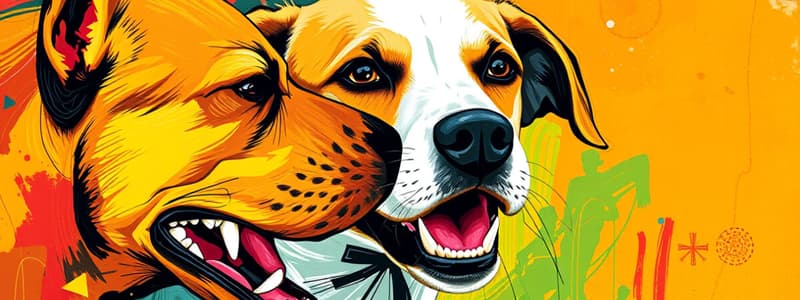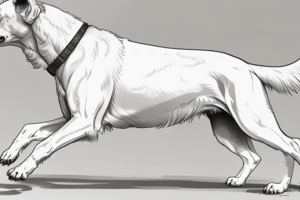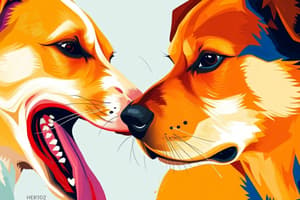Podcast
Questions and Answers
What defines aggression in canine behavior?
What defines aggression in canine behavior?
- The intent to do harm (correct)
- A defensive action
- Any dominant act
- Any aggressive type of display
Is lack of exercise a common cause of aggression?
Is lack of exercise a common cause of aggression?
- Only in certain breeds
- It depends on the dog's age
- True
- False (correct)
Which type of aggression can result from a dog redirecting its aggression towards another target?
Which type of aggression can result from a dog redirecting its aggression towards another target?
- Territorial aggression
- Predatory aggression
- Re-directed aggression (correct)
- Fear-induced aggression
Predatory aggression in dogs is characterized as:
Predatory aggression in dogs is characterized as:
Which statement is false regarding the punishment of aggressive behaviors in dogs?
Which statement is false regarding the punishment of aggressive behaviors in dogs?
Which of the following is NOT a main concept for successful treatment of leash reactivity?
Which of the following is NOT a main concept for successful treatment of leash reactivity?
What behavioral issue is indicated when a dog stops responding to a stimulus due to lack of consequence?
What behavioral issue is indicated when a dog stops responding to a stimulus due to lack of consequence?
Which of the following statements regarding hypothyroidism is true?
Which of the following statements regarding hypothyroidism is true?
Which reason is commonly associated with the creation of resource guarding in dogs?
Which reason is commonly associated with the creation of resource guarding in dogs?
What is necessary for maintaining proper behavior in reactive dogs over time?
What is necessary for maintaining proper behavior in reactive dogs over time?
What is an example of a method used when a dog lunges at others and is instructed to lie down?
What is an example of a method used when a dog lunges at others and is instructed to lie down?
Which factor is not associated with the likelihood of developing dog aggression?
Which factor is not associated with the likelihood of developing dog aggression?
How can reactivity in dogs be best defined?
How can reactivity in dogs be best defined?
What type of correction does a prong collar imply?
What type of correction does a prong collar imply?
What is the key principle of classical conditioning?
What is the key principle of classical conditioning?
Which of the following best defines aggression?
Which of the following best defines aggression?
What is a common misconception about exercise and its relation to aggression?
What is a common misconception about exercise and its relation to aggression?
Which type of aggression is not truly considered aggression?
Which type of aggression is not truly considered aggression?
Which statement regarding idiopathic aggression is accurate?
Which statement regarding idiopathic aggression is accurate?
What misconception about punishing aggressive behaviors is highlighted?
What misconception about punishing aggressive behaviors is highlighted?
If a dog is lunging at other dogs and the owner asks for a down, which technique is being demonstrated?
If a dog is lunging at other dogs and the owner asks for a down, which technique is being demonstrated?
Which of the following is NOT associated with the development of dog aggression?
Which of the following is NOT associated with the development of dog aggression?
What best defines 'reactivity' in dogs?
What best defines 'reactivity' in dogs?
What is the first step in classifying a behavioral technique in operant conditioning?
What is the first step in classifying a behavioral technique in operant conditioning?
Which statement best describes classical conditioning?
Which statement best describes classical conditioning?
Which three main concepts are essential for successful treatment of leash reactivity?
Which three main concepts are essential for successful treatment of leash reactivity?
What is the term for when behavior affected by extinction is likely to reappear when the trigger is reintroduced?
What is the term for when behavior affected by extinction is likely to reappear when the trigger is reintroduced?
Which condition is associated with a deficiency of the thyroid hormone?
Which condition is associated with a deficiency of the thyroid hormone?
In what scenario can aggression due to pain be accurately explained?
In what scenario can aggression due to pain be accurately explained?
What is the most common reason that leads to resource guarding in dogs?
What is the most common reason that leads to resource guarding in dogs?
Flashcards are hidden until you start studying
Study Notes
Definitions and Concepts
- Aggression: Intent to do harm, distinct from dominant or defensive actions.
- Re-directed Aggression: Occurs when a dog attacks its owner after fighting another dog or when two excited dogs fight while barking at something off-premise.
- Predatory Aggression: Recognized as a genuine form of aggression.
- Idiopathic Aggression: Commonly referred to as rage syndrome, characterized by no identifiable cause.
Factors Influencing Aggression
- Pain-Induced Aggression: Not solely explainable by visible painful conditions.
- Resource Guarding: Originates when dogs learn that humans approaching their food/treat leads to the loss of their item, prompting defensive behavior.
- Contributing Factors: Anxiety, fear, phobia, territorial behavior, and traumatic experiences. Lack of exercise is not a direct contributing factor.
Reactive Dogs
- Impulse Control: Many reactive dogs struggle with impulse control, necessitating ongoing training and management.
- Learned Irrelevance: Dogs may stop responding to stimuli due to a lack of consequences.
Treatment Approaches
- Leash Reactivity Treatment: Involves desensitization, counter conditioning, and counter commanding as key concepts.
- Management: Essential for maintaining appropriate behaviors in reactive dogs, requires lifelong commitment.
Conditioning Techniques
- Operant Conditioning: The first step involves determining whether the behavior is being increased or decreased.
- Classical Conditioning: Learning through association, where a stimulus elicits a conditioned response.
Reinforcers
- Primary Reinforcers: Include food, water, and shelter.
Misconceptions and Notes
- Punishing Aggressive Behaviors: Misunderstood; such actions may increase a dog's anxiety rather than reduce aggression.
- Reactivity: Defined as an over-reaction to perceived stimuli, typically beginning with a negative association with other dogs.
- Corrective Techniques: Positive punishment to be cautious about, as it can lead to adverse consequences.
Additional Insights
- Extinction: Behavior affected by extinction may re-emerge when the stimulus is reintroduced, a concept known as spontaneous recovery.
Studying That Suits You
Use AI to generate personalized quizzes and flashcards to suit your learning preferences.




